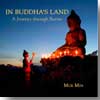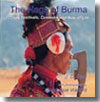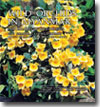| Our Publications | ||
| Books by Title | ||
| Books by Author | ||
| Books by Country | ||
| E-books | ||
| About | ||
| Orchid Press E-books | ||
| Distributed E-books | ||
| Our Bookshop | ||
| About Us | ||
| Browse Shop | ||
| How to Buy | ||
| Contact Us | ||
| WE BUY BOOKS AND LIBRARIES | ||
|
||
Orchid Books
Orchid Books is a collection of well illustrated books, appealing to both the layman and the scholar, and written by specialists.| Central & North-East Asia | Burma | South Asia |
| Thailand & South-East Asia | Himalaya & Tibet | China |
Burma
 |
Burmese Lacquerware by Sylvia Fraser-Lu 2000. 222 pages, 361 colour plates, 19 black and white plates, 20 line drawings. 23 x. 22 cm. ISBN-10: 974-8304-82-5 Softbound: Out of Print ISBN-13: 978-974-8304-82-3 ISBN-10: 974-8304-83-3 Hardbound: Out of Print ISBN-13: 978-974-8304-83-0 For the past 200-300 years the art of lacquer has been one of the show industries of Burma. Early travellers to that country have commented most favourably on it and it would be a rare Burmese household or monastery which did not have at least a few prized pieces of lacquer. The initial impetus for the development of the craft in all probability came from neighbouring China and Thailand, but Burmese creative genius channelled it in new and unique directions. Burma’s polychrome incised wares are unsurpassed for their boldness and liveliness of design while its gilt molded lacquer inlaid with glass mosaic ‘outshines’ European ormolu work in its sheer sumptuous effect. The best of Burma’s gold-leaf design work is equal to that of Thailand, the leading exponent of the craft in South-East Asia. Painted wares, too, are emblematic of a robust folkcraft tradition. Over the years the Burmese lacquer worker has been most adept at adapting to changing circumstances brought about by the colonial experience and post-war independence. To meet the needs of a diverse clientele, artisans have added different colours, new forms and experimental techniques to the repertoire. Despite modern innovations, the lacquer artisan continues to draw strength from the past. Ancient temple murals continue to provide much inspiration and subject matter. This book explains the various technologies practised by lacquer artisans, and describes the various forms, and the use of a wide range of wares. It also introduces the reader to some of the leading exponents of the art in different parts of Burma. Lacquerware collections both within that country and abroad have also been described. [Read a review] |
 |
The Buddhist Murals of Pagan Timeless Vistas of the Cosmos by Claudine Bautze-Picron with photography by Joachim Karl Bautze 2003. 280 pp., 253 colour plates. 28 x 22 cm. Hardbound. ISBN-10: 974-524-025-7 Out of Print ISBN-13: 978-974-524-025-4 Treasures hide in the temples of Pagan—treasures in part never meant to be seen, enshrouded in the darkness of high vaults. They compose a unique ensemble in the Buddhist world of the eleventh to fourteenth century, giving us a glimpse of a lost splendour, and providing evidence of the major political, religious and artistic position that Pagan then held. Adorning the walls and ceilings of those monuments, they constitute a prayer to the Buddha: to the Buddha as a human being, to his last life, but also to his numerous lives when he was in search of the truth. This comprehensive study covers, for the first time, not only the murals found within temples near the historic city of Pagan, but also those within the monuments scattered elsewhere over the Pagan plain. Following an initial iconographic analysis, the author proceeds to reconstruct the overall vision of the murals within the broader context of the interior spaces of the temples, revealing these monuments as visualizations of the Buddhist cosmos and reflecting the cosmological nature of the Buddha. Author Bautze-Picron is an authority on early Indic Buddhist art and her erudite descriptions of these lost treasures are complemented by a magnificent photographic record of the surviving murals themselves. Essential reading for all with interest in the history and diversity of Buddhist art. [Read a review from Cambridge University Press] [Read a review from Artibus Asiae] [Read a review from the Asian Arts Society of Australia] [Read a review from the Journal of the Siam Society] |
 |
Burma’s Lost Kingdoms Splendours of Arakan by Pamela Gutman, photography by Zaw Min Yu 2001. 188 pp., 180 colour and b/w photos, 5 maps, chronology, bibliography, glossary, index. 28.5 x 22 cm. Hardbound. ISBN-10: 974-8304-98-1 Out of Print ISBN-13: 978-974-8304-98-4 Along the Bay of Bengal, in the northwest corner of Burma, lie the splendid capital cities of ancient Arakan: Dhanyawadi, Vesali, the cities of the Lemro valley and Mrauk-U (Myohaung). Mentioned in Ptolemy’s Geography in the 2nd century AD, Arakan was from earliest times a cosmopolitan state with a vigorous and complex culture. Indian Brahmins conducted the royal ceremonial, Buddhist monks spread their teaching, traders came by land and sea, and artists and architects used Indian and Southeast Asian models for inspiration. Through Buddhism, Arakan came into contact with other remote countries, including Sri Lanka, Nepal, Tibet and China. To the east were the many early empires of Southeast Asia: Mon, Khmer, Burman and Siamese, and to the west Hindu empires were replaced by the Islamic courts of Bengal and Delhi. This is the first comprehensive study on the history and civilization of Arakan. It serves as an excellent introduction to its hitherto almost unknown schools of sculpture and architecture. [Read a review from International Quarterly for Asian Studies] [Read a review from Tai Culture magazine] [Read a review from Asian Perspectives] [Read a review from the Antiquity] |
 |
Festivals and Flowers of the Twelve Burmese Seasons by Khin Myo Chit. Illustrations by Paw Oo Thet 2002 132 pp., 114 colour illustrations, glossary. 21 x 19 cm., hardbound. ISBN-10: 974-8299-56-2 $29.00 ISBN-13: 978-974-8299-56-3 Classical Burmese literature abounds with poems that describe the seasons, and this book is a celebration of the Burmese seasons or months, their poets, flowers, festivals and cycles of traditional monthly activities. Written with wit, spirit and insight by Khin Myo Chit and illustrated with the incomparable watercolours of the late Paw Oo Thet. |
 |
The Illusion of Life Burmese Marionettes by Ma Thanegi 1995. viii, 108 pp., 101 colour plates, 17 b & w drawings. 22 x 19 cm., softbound. ISBN-10: 974-8304-03-5 $23.00 ISBN-13: 978-974-8304-03-8 In the 18th and 19th centuries, Burmese marionettes enjoyed a rare and powerful privilege as speakers for both kings and subjects. Never merely for entertainment, puppetry was a high art held in much esteem. Marionettes were means of making people aware of current events; a medium for educating the masses in literature, history and religion; a display of lifestyle and customs. These yoke-thei, ‘small dolls’, enjoyed greater freedom of speech, dress and movement than live performers. They therefore played a significant role in the development of dance and dramatic arts. The author is a well known Burmese painter, and this lively book is liberally spiced with information about Burma and Burmese ways. It contains a systematic presentation of the Burmese marionette tradition, a tradition in danger of extinction. [Read a review] |
 |
In Buddha’s Land Visions of Buddhist Burma Photography by Moe Min 2007. 128 pp., 92 col. pl., 22 x 23 cm. hardcover ISBN-10: 974-524-072-9 $30.00 ISBN-13: 978-974-524-072-8 A spectacular panoramic view of the lives of the Buddhist faithful of Burma, as revealed by award-winning Burmese photographer Moe Min. Through images of Buddhist rituals, both moments of solitary worship and joyous festivals, as well as of temples, shrines and sacred images, the viewer is introduced to the lives of the lay practitioners and monks of this deeply religious land. With magnificent images of world-renowned sites such as Pagan and the Shwedagon, as well as of remote locations rarely reached by the foreign visitor, this book is essential both for those who are well acquanited with this ancient, picturesque land and for those who are not, but wish to be. [Read a review & excerpts from Bangkok Airways In-flight Magazine] |
 |
The Naga of Burma by Jamie Saul with photography by Dominique Viallard 2005. 214 pp., 213 col. pl., 12 b&w pl., 56 sketches, 3 maps, notes, bibliography, index, 22 x 23 cm. Softcover ISBN-10: 974-524-065-6 $36.00 ISBN-13: 978-974-524-065-0 In the words of Alan Macfarlane, Professor of Anthropological Science in the Department of Social Anthropology at the University of Cambridge, ‘. there has long been a largely empty tract covering the eastern half of the Naga area. Because Burma has long been almost closed to visitors, including anthropologists, the rich materials on Naga culture from that area have remained un-recorded and unknown. It is as a contribution to filling in the facts on this area in particular, but also for the light it throws back on the Assam Naga, that we can welcome Jamie Saul’s monograph as a major addition to the ethnography of the Naga peoples.’ This book is the result of over 30 years of study by the author on the Burmese Naga groups inhabiting the area ranging between the Chindwin River and the international border with India. Building up on a base of unpublished official tour diaries and reports dating from the 1800s, the author made several visits to the Naga regions on both sides of the border and carried out research among the Naga, establishing contacts and encouraging Nagas themselves to co-operate in the gathering of the materials that form the basis of this book. A wide range of excellent colour illustrations by Dominique Viallard complement the text and, along with sketches relating to the text, provide a visual record of the numerous groups found throughout the Burmese Naga region. The book introduces the Naga at their New Year festival held at Lahe and then moves on to chapters dealing with the breakdown of the different groups and their linguistic connections according to recent research, as well as covering other aspects such as tattoo, costume, architecture, social structure, life cycle, religion and festivals, arts and crafts, human sacrifice, lycanthropy, warfare and head-hunting. [Read a review from the Journal of Humanities and Social Sciences of SE Asia and Oceania] |
 |
Splendour in Wood The Buddhist Monasteries of Burma by Sylvia Fraser-Lu 2001. 344 pp., richly illustrated with over 200 colour plates, and over 150 halftones and line drawings of plans, elevations and architectural details, map, dynastic table, glossary, bibliography, index. 28.5 X 22 cm., hardbound. ISBN-10: 974-8304-16-7 $60.00 ISBN-13: 978-974-8304-16-8 Burmese wooden monasteries and related pavilions have not received the scholarly attention that they deserve. This is unfortunate, given the especially ephemeral nature of wood in a damp tropical climate, with voracious insect life and the ever-present risk of floods, fire and earthquakes. Many extant structures are in a very dilapidated condition; the original donors have moved away, and/or their descendants no longer have adequate financial resources to maintain a forebear’s work. This book introduces the reader to the beauty and genius of Burmese craftsmanship as expressed in the construction and embellishment of Buddhist wooden monasteries. The five chapters of Part I review the development of Buddhism and monasteries in Burma, the place of monks and monasteries in society, and the processes in building a monastery. Detailed accounts of monastic establishments in the pre-colonial, colonial and post-colonial eras are also presented. In the three chapters of Part II are descriptions of nearly ninety different edifices visited by the author in the course of her research, in Upper and Lower Burma, and Central Burma and the Shan states. For posterity, the details of many wooden monasteries are recorded – not only the ‘old’ and the ‘beautiful’, but also others with architectural features of note. The book is copiously illustrated with sketches of floor plans and architectural details of many monasteries, and photographs of significant features. [Read a review] |
 |
Wild Orchids in Myanmar Vol. 3 Shangri-La of Wild Orchids by Dr Yoshitaka Tanaka, Nyan Htun & Tin Tin Yee 2007, 108 pp., 152 colour illustrations, references, hardbound, 27.5 x 26 cm. ISBN-10: 998-97764-9-9 $48.00 ISBN-13: 978-988-97764-9-7 The third volume of a planned series of six, the present book focuses on the wide variety of orchid species to be found at high altitudes on and in the vicinity of Victoria Mountain, in the Chin State, close to Burma’s border with Bangladesh. While Dendrobium is perhaps the most frequently encountered family, a rich assortment of other species are illustrated and described, some of which still require further taxonometric research. Here, despite its extreme remoteness, road development and the encroachment of poachers is also beginning to take its toll on the rich diversity of orchids that occur naturally in this rugged terrain. Orchid lovers worldwide owe a dept of gratitude to Dr Tanaka’s continued efforts to record and protect these fragile beauties. Bilingual English / Japanese text. |
 |
A Wonderland of Burmese Legends by Khin Myo Chit Illustrated by Paw Oo Thet. 1984. vii, 126 pp., 48 col. pl., 1 map. 21 x 19 cm., softbound. ISBN-10: 974-8304-01-9 $19.00 ISBN-13: 978-974-8304-01-4 This richly illustrated book takes the reader on a journey through the legendary and famous places of Burma, and relates the legends associated with each place, legends which are in the blood and soul of every Burmese, young or old. The author takes us from Rangoon, Pegu and Prome to Sriksetra and up the Irrawaddy to Mandalay and Sagaing, a journey accompanied by the magic watercolours of the late Paw Oo Thet, Burma’s best loved contemporary artist. An indispensable companion and guide to contemporary Burmese life and thought. |
PO Box 70, Trinity TB, NL, A0C 2S0, Canada
Telephone: +1 709-330-4703